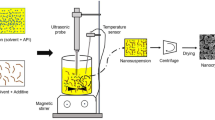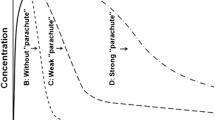Abstract
The aim of this study was to prepare APAP crystals by cooling, anti-solvent, and solvent evaporation crystallization to enhance its dissolution rate and to make comparisons of the three methods. Agitating speeds and types were regarded as factors affecting crystallization procedure. Samples were made with different ratios of PEG4000. They were characterized by X-ray diffraction and scanning electron microscopy. Dissolution tests were conducted to assess their dissolution property. The proportions of carriers existing in crystals by cooling and anti-solvent crystallization ranged from 1.3 to 5.1%. Mean dissolution time (MDT) of samples by the two methods was about 3 min, which was 17.2 min for untreated APAP. Addition of too much PEG4000 in solvent evaporation crystallization could decrease dissolution rate of APAP. Samples agitated by a rotor with speed of 100, 500, and 1000 rpm dissolved faster than those by a high shear mixer with speed of 3400 and 5000 rpm or by a glass rod. Agitating speed and type could affect particle size and drug dissolution. Dissolution enhancement of APAP might be attributed to decrease of fine particles and increase of particle wettability.








Similar content being viewed by others
References
Qiang F, Sun J, Ai X, et al. Nimodipine nanocrystals for oral bioavailability improvement: role of mesenteric lymph transport in the oral absorption. Int J Pharm. 2013;448(1):290–7.
Yuangang Z, Li N, Zhao X, et al. In vitro dissolution enhancement of micronized l-nimodipine by anti-solvent re-crystallization from its crystal form H. Int J Pharm. 2014;464(1–2):1–9.
Jijun F, Lili Z, Tingting G, et al. Stable nimodipine tablets with high bioavailability containing NM-SD prepared by hot-melt extrusion. Powder Technol. 2010;204:214–21.
Liu X, Wang S, Chai L, et al. A two-step strategy to design high bioavailable controlled-release nimodipine tablets: the push-pull osmotic pump in combination with the micronization/solid dispersion techniques. Int J Pharm. 2014;461(1–2):529–39.
Nielsen LH, Gordon S, Holm R, et al. Preparation of an amorphous sodium furosemide salt improves solubility and dissolution rate and leads to a faster Tmax after oral dosing to rats. Eur J Pharm Biopharm. 2013;85(3):942–51.
Yong-Suk Y, Hee OJ, Ho AK, Minsoo K, Jaehoon K, Lee Y-W. Dissolution rate improvement of valsartan by low temperature re-crystalization in compressed CO2: prevention of excessive agglomeration. J Supercrit Fluids. 2011;59:117–23.
Shawky Tous S, Mohammed FA. Improvement of the in vitro dissolution rate of mebendazole via crystallization in aqueous surfactant solutions. J Drug Deliv Sci Tecnol. 2008;18(5):359–66.
Botting R. COX-1 and COX-3 inhibitors. Thromb Res. 2003;110(5–6):269–72.
Granberg RA, Rasmuson AC. Solubility of paracetamol in pure solvents. J Chem Eng Data. 1999;44(6):1391–5.
Mohamed AE, Viviane FN. Thermodynamics of paracetamol solubility in sugar-water cosolvent systems. Int J Pharm. 1989;58(3):177–84.
Khan S, ElShaer A, Rahman AS, Hanson P, Perrie Y, Mohammed AR. Systems biology approach to study permeability of paracetamol and its solid dispersion. Int J Pharm. 2011;417(1–2):272–9.
Yee S. In vitro permeability across Caco-2 cells (colonic) can predict in vivo (small intestinal) absorption in man—fact or myth. Pharm Res. 1997;763–766.
Amidon GL, Lennernäs H, Shah VP. A theoretical basis for a Biopharmaceutic Drug Classification: the correlation of in vitro drug product dissolution and in vivo bioavailability. Pharm Res. 1995;12(3):413–20.
Kalantzi L, Reppas C, Dressman JB, Amidon GL, Junginger HE, Midha KK, et al. Biowaiver monographs for immediate release solid oral dosage forms: acetaminophen (paracetamol). J Pharm Sci. 2006;95(1):4–14.
Zapater P, de la Vega MCL, Horga JF, Such J, Frances R, Esteban A, et al. Pharmacokinetic variations of acetaminophen according to liver dysfunction and portal hypertension status. Aliment Pharmacol Ther. 2004;20(1):29–36.
Tim Grattan A, R.H.A.A, S.W. Malcolm Boyce C, A five way crossover human volunteer study to compare the pharmacokinetics of paracetamol following oral administration of two commercially available paracetamol tablets and three development tablets containing paracetamol in combination with sodium bicarbonate or calcium carbonate. Eur J Pharm Biopharm 2000; 49;3:225–9.
Palma-Aguirre JA, Villalpando-Hernandez J, Novoa-Heckel G, Oliva I, Carino L, Lopez-Bojorquez E, et al. Bioavailability of two oral-tablet and two oral-suspension formulations of naproxen sodium/paracetamol (acetaminophen): single-dose, randomized, open-label, two-period crossover comparisons in healthy Mexican adult subjects. Clin Ther. 2009;31(2):399–410.
Waseem K, Hassan L, Brian C, Saeed S, Ali N. An approach to engineer paracetamol crystals by anti-solvent crystallization technique in presence of various additives for direct compression. Int J Pharm. 2014;464(1–2):53–64.
Garekani HA, Sadeghi F, Salary M. Dissolution of acetaminophen crystallised in the presence of polyvinylpyrrolidone. Pharm Dev Technol. 2004;14(2):141–6.
Shakeel F, Alanazi FK, Alsarra IA, Haq N. Solubilization behavior of paracetamol in transcutol-water mixtures at (298.15 to 333.15) K. J Chem Eng Data. 2013;58(12):3551–6.
Waseem K, Hassan L, Brian C, Saeed S, Ali N. An approach to engineer paracetamol crystals by anti-solvent crystallization technique in presence of various additives for direct compression. Int J Pharm. 2014;464:53–64.
Nichols G, Frampton CS. Physicochemical characterization of the orthorhombic polymorph of paracetamol crystallized from solution. J Pharm Sci. 1998;87(6):684–93.
Luczak A, Jallo LJ, Dave RN, Iqbal Z. Polymorph stabilization in processed acetaminophen powders. Powder Technol. 2013;236:52–62.
Sadeghi F, Torab M, Khattab M, Homayouni A, Garekani HA. Improvement of physico-mechanical properties of partially amorphous acetaminophen developed from hydroalcoholic solution using spray drying technique. Iran J Basic Med Sci. 2013;16(10):1100–8.
Villiers MM, Wurster DE, Van der Watt JG, Ketkar A. X-ray powder diffraction determination of the relative amount of crystalline acetaminophen in solid dispersions with polyvinylpyrrolidone. Int J Pharm. 1998;163(1):219–24.
Billon A, Bataille B, Cassanas G, Jacob M. Development of spray-dried acetaminophen microparticles using experimental designs. Int J Pharm. 2000;203(1–2):159–68.
Yang M, Wang P, Huang C-Y, et al. Solid dispersion of acetaminophen and poly(ethylene oxide) prepared by hot-melt mixing. Int J Pharm. 2010;395:53–61.
Acknowledgments
This work was partially supported by the National Natural Science Foundation of China (No.21176173) and Tianjin Natural Science Foundation (14JCYBJC29100).
Author information
Authors and Affiliations
Corresponding author
Ethics declarations
Conflict of Interest
The authors declare that they have no competing interests.
Rights and permissions
About this article
Cite this article
Chen, R., Wang, X., Liu, W. et al. A Comparative Study on Dissolution Enhancement of Acetaminophen by Cooling, Anti-solvent, and Solvent Evaporation Crystallization. AAPS PharmSciTech 18, 224–230 (2017). https://doi.org/10.1208/s12249-016-0510-6
Received:
Accepted:
Published:
Issue Date:
DOI: https://doi.org/10.1208/s12249-016-0510-6




